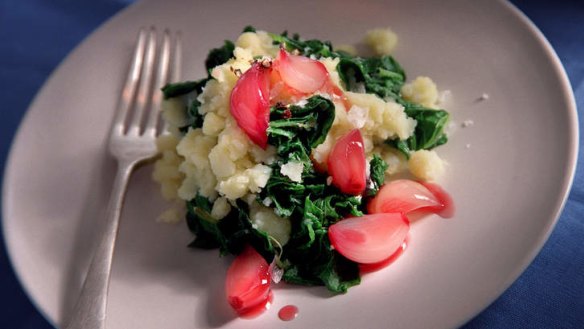How do I avoid lumpy mashed potatoes?

How do I avoid lumpy mashed potatoes? S. McIntyre
I went to a lovely city restaurant recently and was amazed by the smooth consistency and creamy texture of their mashed potatoes. The chef explained he used an equal ratio of butter to potato.
It's the type of food that, if sold in supermarkets, would attract TV reporters screaming at the camera: "The food that is clogging the nation's arteries.'' Speaking of clogging arteries, there is a mashed potato product that is sold in popular fried chicken outlets. This is lumpless because it is made with powdered potatoes.
Some brands of instant mashed potato contain synthetic fat to emulsify the product, disodium pyrophosphate to regulate acidity, and sodium bisulphate as a preservative. Nice. Some potato proponents advise using a blender to smooth out the lumps, but this can lead to gluey mash as the smashing action of the blades releases the starch.
After choosing the right starchy potato, peeling and cooking it until it's soft but not sodden, the single best way of ensuring lump-free mash is to use a potato ricer or rotary handmill such as a Moulinex. To this ''riced'' potato add your warm milk and butter and mix through.
Having just enjoyed the last of my oxtail stew a la Stephanie, is there another cut of beef that offers a flavour almost as good when slow-cooked in a similar stew, without all the bones and fat? J. Croll
May I answer your query by recasting your question? To me it sounds the same as: "Having just enjoyed two weeks in Italy, is there anywhere in Central Queensland where I can enjoy equivalent Roman history, Baroque architecture and Italian Renaissance art treasures?" Fat equals flavour and mouthfeel.
If you want to remove the fat from a slow-cooked meat dish, try a cut close to the bone such as beef shin or trimmed chuck or oyster blade - anything with some connective tissue. Slow-cooked lean meat becomes grainy and not very pleasurable to eat.
The power goes out, the food in the freezer defrosts, but the food is still very cold. Do I throw the lot out? R. White
I feel like Geoffrey Robertson here with food ''hypotheticals'', in which case I would flick about my bouffant and ask: "Is the food still under four degrees and has it only just defrosted?" If this was the case, I would say no. If you're a person who keeps stable foods such as nuts and flour fresh in the freezer, then freeze these again.
Vegetables or animal protein will be OK for a few days, but do not refreeze these. Instead, consider making some sort of stew with them, which in turn could be safely stored in the freezer. As the ice-cream has probably melted, you are going to have to either add it to a smoothie or throw it away.
How come milk is white, French butter is white, but Australian butter is bright yellow? P. Hazzard
True-blue Aussie cows mostly eat grass. Grass contains betacarotene, the stuff that makes carrots orange, and also makes butter yellow.
French cows eat croissants, snails and garlic. Sorry. French cows are more likely to be fed dry and pelletised feed, particularly in winter, which contains less betacarotene, resulting in less colour in the butter.
French butter is almost exclusively wrapped in foil, preventing oxidation that makes the outside layer darker.
Thankfully the Australian dairy industry has followed suit, except for a few brands that still package their butter in inferior paper packaging.
The best recipes from Australia's leading chefs straight to your inbox.
Sign up